Asteroids and us, part II
In the first part, I talked a lot about how modern methods of observational astronomy, tied to gigapixel cameras and petaflop-scale supercomputers, change the approach to asteroid danger, transferring it from theoretical to a more or less practical plane.
Before we talk about the methods of rejecting potential impactors, it is necessary to look once again at the situation with which of the small bodies of the Solar system are dangerous. To begin with, we will divide all small bodies rotating around the Sun into groups according to orbital parameters and select several of them - Near-Earth Asteroids, Main-Belt Asteroids, Centaurs, Kuiper Belt Objects.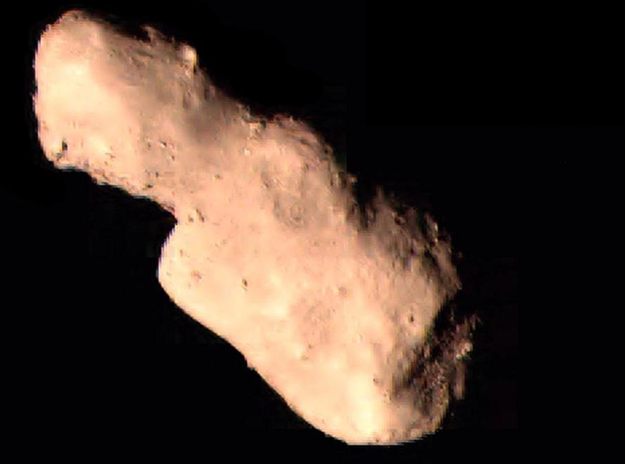
The largest of the potentially dangerous near-Earth asteroids - 4179 Tautatis
The Earth's orbit in 99.5% of cases is crossed by near-Earth asteroids, whose orbit lies somewhere between the asteroid belt and the inner part of the solar system (obviously, inside the Earth's orbit). However, quantitatively it is one of the smallest groups of asteroids. So, today there are about 15,000 near-Earth asteroids and more than 800,000 asteroids of the main belt. However, the orbits of the asteroids of the main belt are stabilized by Jupiter and Uranus, and only as a result of rather rare collisions large enough fragments can go into dangerous orbits. Therefore, despite the large number, the asteroids of the main belt do not pose a significant danger to the Earth.
The next most important source of dangerous bodies is the group of Centaurs - the inner part of the Kuiper belt, located between the orbits of Jupiter and Neptune. This is a dynamically unstable territory, from which small bodies, in conjunction with giant planets, sooner or later flutter in or out of the Solar System, and it is the Centaurs that are the main source of short-period comets. This group of bodies, which is much more difficult to detect than the asteroids of the main belt, or even less near-earth, is the source of almost 0.5% of intersections by small bodies of the Earth’s orbit (we are talking about those Centaurians whose perihelions moved into the Earth’s orbit, and the aphelion remained somewhere then near the orbit of Jupiter, if the aphelion also moves inside the Solar System, then the object goes into the group of near-earth asteroids).
')
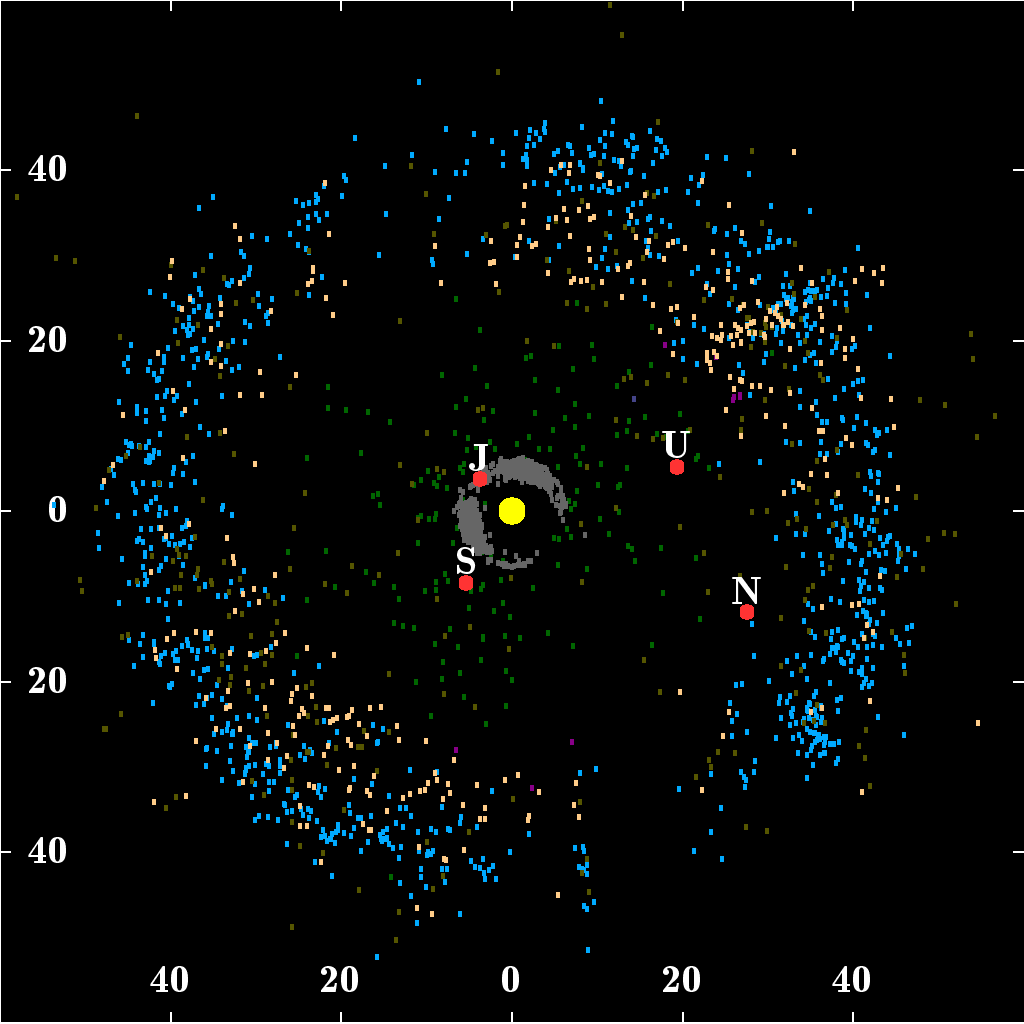
Finally, the outer parts of the Solar System - the Kuiper belt, the scattered disk and the Oort cloud also periodically send “gifts” to the center, called long-period comets (they are defined as comets with a circulation period of more than 200 years). However, despite the huge estimates of the total number of bodies in these groups, the orbital dynamics and low speeds lead to the fact that no more than 3 similar objects with potentially dangerous sizes fly into the Earth’s orbit every year, in fact, against the backdrop of thousands of orbit intersections by near-earth asteroids, the probability get a collision with such a comet is about 0.1% . However, we will return to the objects from the Kuiper belt and the Oort cloud, and now let's talk about the methods of rejecting the new “standard” asteroid.
After astronomers “filtered” all near-earth objects> 1 km in size (157 bodies more than 1 km in size are known to intersect Earth’s orbits, and this number has practically not grown for several years), the standard target on which they began to train the idea of the inventors of various methods of deflecting asteroids became the sensational Apophis - the largest target likely in size and orbit that astronomers are likely to find sooner or later.
Currently, dozens of ways to change the asteroid orbit have been invented. Let's list the most developed of them in order of increasing efficiency. Efficiency will be determined as the mass of the spacecraft that carries out the deviation of the asteroid at the point of the desired deviation (at least ~ 20,000 km).
Chemical rocket engines mounted on an asteroid. Of the benefits only that they are at hand and well known. To impart a minimal impulse (usually estimated at ~ 0.3 m / s), 10-50 million tons of an asteroid need to deliver several tens of thousands of tons of fuel - which means that hundreds of thousands of tons have already been raised to a low earth orbit. In general, this option does not have any advantages, leveling such exorbitant costs.
Electrojet engines, also installed on the asteroid. On the one hand, the mass of fuel can be of the order of tens of tons, since specific impulse ERD is adjusted. On the other hand - there is a serious minus in the form of rotation by an asteroid - engines will be able to give a pulse in the right direction for a small part of the time. Along with the impulse effect, there are usually considered options for stopping the asteroid's rotation or precession of the axis of rotation so that it coincides with the direction to which the thrust is issued (i.e. the remote control move to the pole, more precisely, the pole to remote control). In general, if we have many decades, then this is the most realistic option - the technology is less ready.
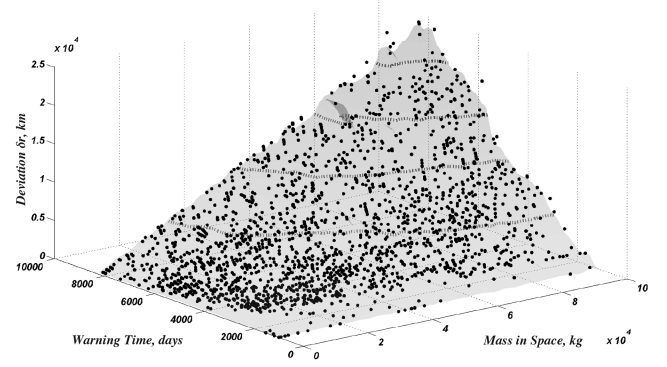
The result of the simulation of the use of spacecraft with electric propulsion to the potential Apophis. On one axis, the time is postponed from the moment of detection, with the first 1000 days being the creation, launch, and flight to an asteroid, and then the time of exposure goes. On the other axis is the available mass of the apparatus in tens of tons. On the third - the asteroid's deviation from the initial trajectory is reached.However, there is a rather interesting re-naming of this solution, called the “gravity tug”. Here we do not install the propulsion system with tanks on the surface, but hang it near the asteroid, preventing it from being attracted to the asteroid by the engines. Mutual attraction gradually pulls the stone from orbit (yes, yes!), Doing the work we need. The most important thing here is not to let the jets from the engines hit the asteroid, it is necessary to position our remote control at angles to the line connecting the spacecraft and the asteroid. In general, the efficiency per kilogram is lower than that of solution No. 2, but we are not worried about the rotation of the cosmic body - and the work is done 24x7, so in this way it is possible to reduce the time it takes for the body to go with a dangerous trajectory.
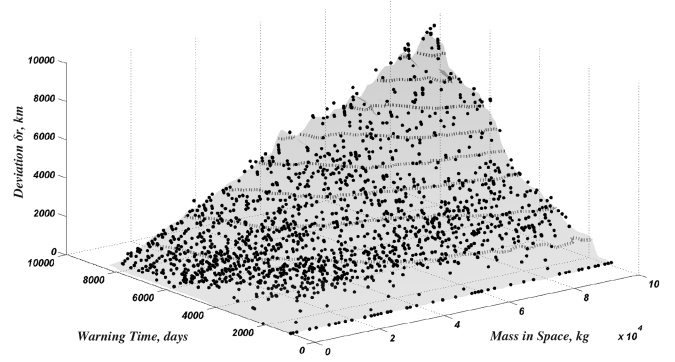
Similar simulations for gravity tugs.Impact. Just overclocked disc at a speed of several km / s crashes into an asteroid, giving it a boost. Everyone has a good solution (and already once implemented for teaching and training purposes on the comet Tempel in 2005), except for low efficiency. If we take the same long-suffering Apophis, then a 100-tonne spacecraft, correctly driven into it as much as 20 years before the collision (I’d remind you that NASA had 25 years from detection to a possible collision, which later became impossible) would cause it to only 12,000 km. Although it is equal to the diameter of the Earth, i.e. It seems to be obviously sufficient, such accuracy is somewhere on the verge of measurement and modeling errors, i.e. I would like to be able to remove the body to 20-30-40 thousand km.
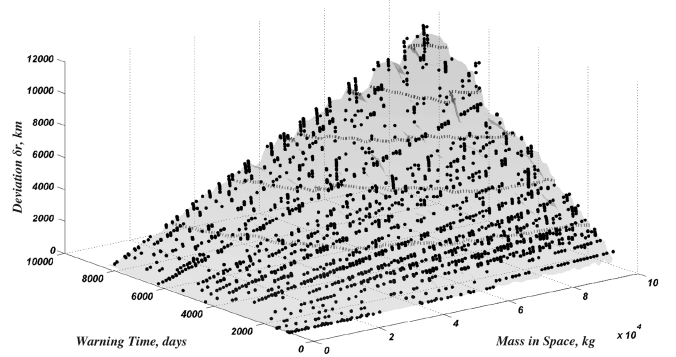
Simulation for a shock spacecraft.The following idea has much less elaboration, but is quite beautiful. We have a focusing mirror next to the asteroid being removed, which heats a point on the surface to, say, 1600 ° C - even olivine, of which S and C asteroids mainly consist, begins to evaporate intensively into a vacuum, creating traction. The principal problem can only be the rapid rotation of the asteroid - if the spot does not have time to warm up, then we will not get the thrust. Nevertheless, there are technical problems with the car: it is necessary to precisely hold the mirror in the desired position, to refocus our beam at different distances (because the asteroid is not an ideal sphere, but a hilly stone), eventually inflatable mirrors with a diameter of 50 ... 100 meters optical quality of the surface no one put into space. But the theoretical efficiency of this method is very high, it is higher than that of nuclear bombing (!).
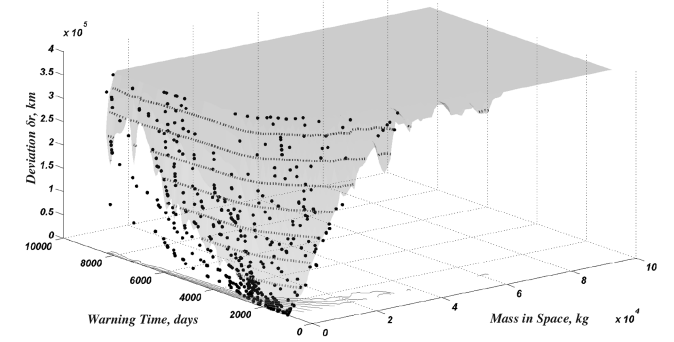
Simulation for a solar concentrator. "Plateau" here - exceeding the distance of the deviation of a dangerous object beyond the limits of the moon's orbit, after which the simulation stopped. It can be seen that with the same mass of the machine at ~ 10 tons, it is able to cope with rather rather large asteroids.Even more theoretical is the idea of a “mass driver” - an electromagnetic catapult, throwing pieces of an asteroid, and thus giving it a boost in the right direction. At first glance, it’s a good idea to do without the reactive mass brought from Earth, but obviously requiring a large number of different machines running on the asteroid — the catapult itself, the miners ’robots, the factory making the projectiles, the repair of all this. At present, there are not even prototypes of such equipment, but its development will not hurt, even if you never need to reject asteroids in this way.
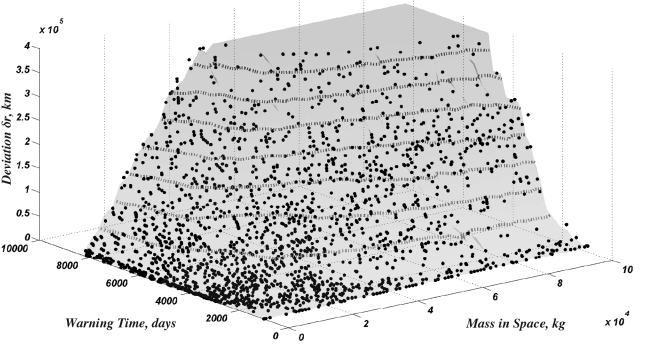
Simulation for a catapult - it is clear that the effectiveness of this scheme drops rapidly with decreasing mass of the spacecraft, but nevertheless it is very high.However, if we want to minimize not only the reactive mass, but also the machinery, that is, the option of asteroid movement due to the YORP effect. Roughly, we are talking about the fact that the rotating stone is heated on one side, and cold on the other, so there is an asymmetry of thrust due to a kind of “photon engine” on IR photons. This effect is small, but due to the coloring of the asteroid with reflective and absorbing paint, it is possible to achieve displacement of thousands and tens of thousands of kilometers over decades. But only for small asteroids, no larger than 150 m in size, because for the YORP effect, the area-to-volume ratio is important. It is estimated that for a dangerous asteroid with a size of ~ 100 meters you need only 2-3 tons of paint of two colors, i.e. such a spacecraft painter is likely to be able to run the existing media.
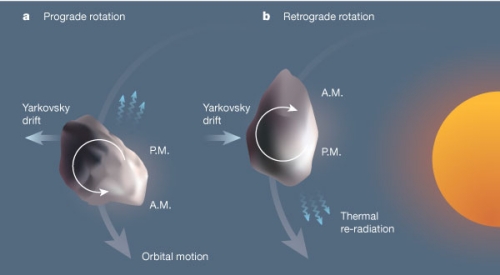
Explanation of one of the main parts of the YORP - Yarkovsky effect, causing a displacement of the orbit.We are getting to the blog topic - a super-surface nuclear explosion. The energy density in a nuclear weapon allows you to work wonders and transmit a decent impulse in an instant. Nuclear warheads, especially against bodies with a diameter of less than 1 kilometer, give effect even if there is little time left before a possible collision with the Earth. However, it is interesting that the result significantly depends on the height of the explosion above the surface, and the channels for the release of energy from a nuclear explosive device. Assuming that the warhead has the parameters of the BB ICBM R-36M, i.e. a power of 750 kt and a weight of 600 kg, then the transmitted impulse to the Apophis asteroid will be ~ 0.3 m / s with an optimum height of detonation of 48 meters. So, at a distance of 20,000 km after this, the asteroid leaves in ~ 2 years. Surprisingly, a significant part of the pulse is transmitted by heating and sublimating the surface with neutron radiation - X-rays are absorbed in a too thin layer from the surface, and rather overheat it, but the neutrons are optimal. Those. Immediately visible path optimization - two-stage thermonuclear warheads of maximum mass, which is technically possible to send to the asteroid, in the extreme case - with deuterium-tritium fuel, and not deuterium-lithium (which gives much less neutrons).
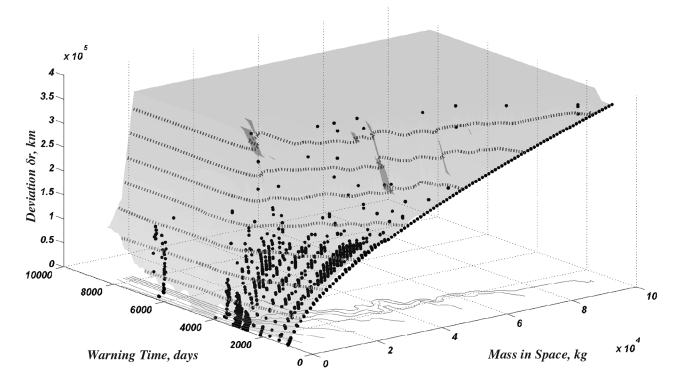
Similar simulations for nuclear bombing.Finally, the last selected option is a recessed nuclear explosion. If earlier this meant drilling on an asteroid of a certain well where a charge was laid, now modeling shows that the location of the YAB inside an impactor that enters the body at a speed of several km / s and undermining just a few meters below the surface in the crater provides about the same pulse. This time it is provided with a mass of debris with an average speed of ~ 80-100 m / s, which means a much higher use of nuclear energy - to drive away an asteroid of mass with the long-suffering Apophis (I hope no one reads the asteroid protection literature on Apophis) on a distance of 20,000 km from the aiming point to the Earth is now possible in 10-15 days (!). Currently, this option is ultimatum, including providing a possible salvation from long-period comets. I recall that such comets, although very unlikely candidates for the Apocalypse, are undetectable earlier than 9-12 months before the impact date, although a viewing telescope with a diameter of 12-15 meters or space-based could significantly extend this period.
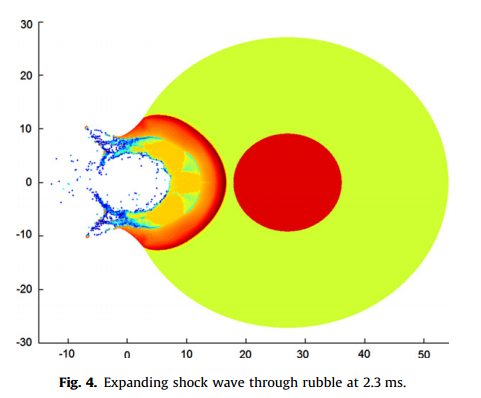
A small spherical asteroid in a vacuum and the initial stages of a 50 kt impactor explosion. After 30 milliseconds of the stone will be the horns and legs.
It is necessary, however, to recall a couple of minuses of a deepened nuclear explosion. First of all, it is the dependence of the impulse of the explosion on the internal structure of the body, a certain amount of debris, still falling to the ground (however, bodies smaller than 10 meters, as we know, are almost completely safe - it is unlikely that fragments larger than this will appear as a result of the explosion) , well, the traditional weak elaboration of such spacecraft, although here how to look - the military seems to have nuclear penentors that are buried in the ground at a speed of several km / s (remember the test of this Mr. on the rocket trolley on the track to 2 km / s?).
Estimated loss of debris (of unclear size) when Apophis is deflected by a penetrating nuclear penetrator 20 days before the collision.
Another rather fatal minus of a nuclear weapon to repel an asteroid threat is the multitude of political and security restrictions on the use of nuclear weapons in space. So far there are only mechanisms to counter the launch of a nuclear bomb to an asteroid, and there are no mechanisms to quickly implement this task. And if time is not important - as we can see, there are methods and no worse, and somewhere more interesting.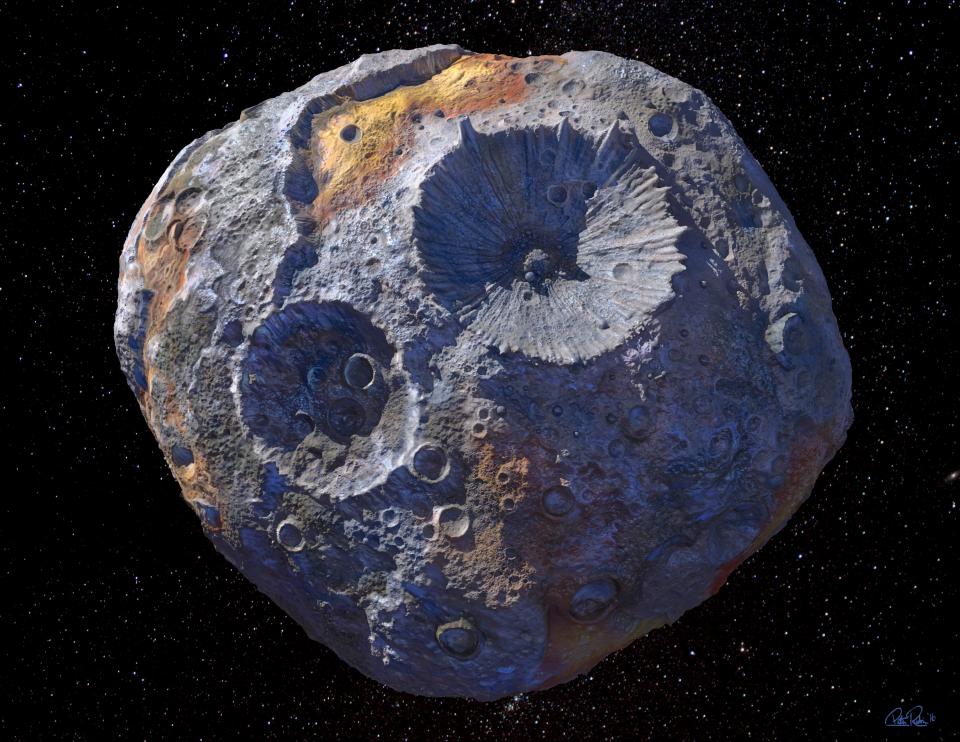
Metallic asteroid Psyche in the view of the artist.
In the meantime, only telescopes and research missions to asteroids receive money - for today, the Chinese apparatus Chanye-2, flying asteroid 4179 Tautatis, the Hayabus-2 asteroid program for Ryugu ascending are in orbit; also a potentially dangerous object) and OSIRIS-REx to 101955 Benn (another largest of the asteroids potentially dangerous to the Earth - do you notice a trend?).
Just recently, NASA also chose to finance an orbiter to one of the largest asteroids of the main belt, Psyche 16 (its peculiarity is that it consists almost entirely of metal - iron, nickel and cobalt, with a weight of several trillion tons) and the mission of the flight of 6 asteroids from the Trojans - the bodies locked in the Lagrange points in the orbit of Jupiter. In this selection, by the way, lost the NEOCam space telescope, designed to search for near-Earth asteroids in the infrared range from the Lagrange point L1, but it was decided to continue its development.
PS There is a rather amusing impact simulator that allows you to calculate the consequences of the collisions of the Earth with asteroids. Not very visual (textual conclusions), but very detailed in terms of consequences.
Source: https://habr.com/ru/post/400599/
All Articles